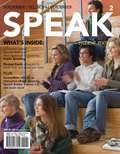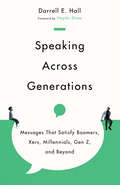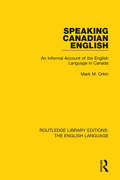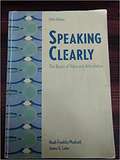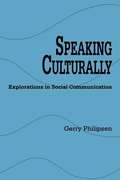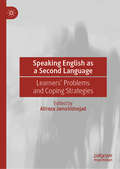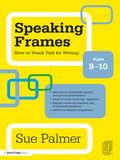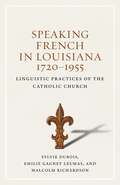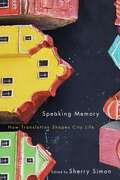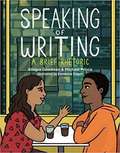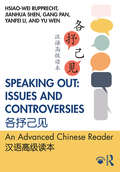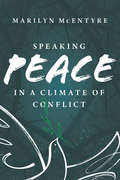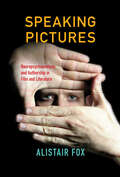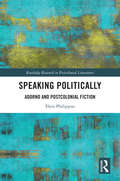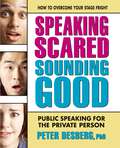- Table View
- List View
Speak, Memory: An Autobiography Revisited (Vintage International)
by Vladimir NabokovFrom one of the 20th century's great writers comes one of the finest autobiographies of our time. • "Scintillating … One finds here amazing glimpses into the life of a world that has vanished forever." —The New York Times Speak, Memory was first published by Vladimir Nabokov in 1951 as Conclusive Evidence and then assiduously revised and republished in 1966. Nabokov's memoir is a moving account of a loving, civilized family, of adolescent awakenings, flight from Bolshevik terror, education in England, and émigré life in Paris and Berlin. The Nabokovs were eccentric, liberal aristocrats, who lived a life immersed in politics and literature on splendid country estates until their world was swept away by the Russian revolution when the author was eighteen years old. Speak, Memory vividly evokes a vanished past in the inimitable prose of Nabokov at his best.
Speak: A Process Approach
by Rudolph F. Verderber Kathleen S. Verderber Deanna D. SellnowNIMAC-sourced textbook <P><P>Created through a "student-tested, faculty-approved" review process with hundreds of students and faculty, SPEAK2 is an engaging and accessible solution to accommodate your diverse lifestyle. SPEAK2 guides you through the speechmaking process with six Speech Plan Action Step activities that prompt you to develop effective speeches. With the help of sample speeches, chapter review cards, numerous online tools, techniques to help you address anxiety and ethical issues, and much more, SPEAK2 gives you an exceptional foundation for creating and delivering speeches.
Speaking Across Generations: Messages That Satisfy Boomers, Xers, Millennials, Gen Z, and Beyond
by Darrell E. HallDifferent generations communicate differently.
Speaking Being: Werner Erhard, Martin Heidegger, and a New Possibility of Being Human
by Bruce Hyde Drew KoppSpeaking Being: Werner Erhard, Martin Heidegger, and a New Possibility of Being Human is an unprecedented study of the ideas and methods developed by the thinker Werner Erhard. In this book, those ideas and methods are revealed by presenting in full an innovative program he developed in the 1980s called The Forum—available in this book as a transcript of an actual course led by Erhard in San Francisco in December of 1989. Since its inception, Erhard’s work has impacted the lives of millions of people throughout the world. Central to this study is a comparative analysis of Erhard’s rhetorical project, The Forum, and the philosophical project of Martin Heidegger. Through this comparative analysis, the authors demonstrate how each thinker’s work sometimes parallels and often illuminates the other. The dialogue at work in The Forum functions to generate a language which speaks being. That is, The Forum is an instance of what the authors call ontological rhetoric: a technology of communicating what cannot be said in language. Nevertheless, what does get said allows those participating in the dialogue to discover previously unseen aspects of what it currently means to be human. As a primary outcome of such discovery, access to creating a new possibility of what it is to be human is made available. The purpose of this book is to show how communication of the unspoken realm of language—speaking being—is actually accomplished in The Forum, and to demonstrate how Erhard did it in 1989. Through placing Erhard’s language use next to Heidegger’s thinking—presented in a series of “Sidebars” and “Intervals” alongside The Forum transcript—the authors have made two contributions. They have illuminated the work of two thinkers, who independently developed similar forms of ontological rhetoric while working from very different times and places. Hyde and Kopp have also for the first time made Erhard’s extraordinary form of ontological rhetoric available for a wide range of audiences, from scholars at work within a variety of academic disciplines to anyone interested in exploring the possibility of being for human beings. From the Afterword: I regard Speaking Being as an enormously important contribution to understanding Heidegger and Erhard. The latter has received far too little serious academic attention, and this book begins to make up for that lack. Moreover, the book’s analysis of Heidegger’s thought is among the best that I have ever read. I commend this book to all readers without reservation. Michael E. Zimmerman, Professor Emeritus, University of Colorado, Boulder
Speaking Canadian English: An Informal Account of the English Language in Canada (Routledge Library Editions: The English Language #21)
by Mark M. OrkinWhat do English-speaking Canadians sound like and why? Can you tell the difference between a Canadian and an American? A Canadian and an Englishman? If so, how? Linguistically speaking is Canada a colony of Britain or a satellite of the United States? Is there a Canadian language? Speaking Canadian English, first published in 1971, in a non-technical way, describes English as it is spoken in Canada – its vocabulary, pronunciation, syntax, grammar, spelling, slang. This title comments on the history of Canadian English – how it came to sound the way it does – and attempts to predict what will happen to it in the future. This book will be of interest to students of linguistics.
Speaking Clearly: Improving Voice and Diction (Sixth Edition)
by Jeffrey C. Hahner Martin A. Sokoloff Sandra L. SalischSpeaking Clearly: The Basics of Voice and Articulation (Fifth Edition)
by Noah Franklin Modisett James G. LuterTo help you to understand how speech is produced and to guide you in the improvement of your speech production. Specifically, it provides instruction in the processes of respiration, phonation, resonation, and articulation and their coordination in pronunciation and effective vocal expression.
Speaking Culturally: Explorations in Social Communication
by Gerry PhilipsenSpeaking Culturally is written to introduce students to the ethnography of communication by presenting a series of cases and commentaries pertaining to speaking.
Speaking English as a Second Language: Learners' Problems and Coping Strategies
by Alireza JamshidnejadThis book focuses on understanding the process of problem construction in oral communication in foreign language contexts, examining how speakers of English as a second language approach issues in oral communication, as well as the strategies they employ to overcome these difficulties. Using theories of general communication, and in particular current approaches to L2 oral communication and strategies in interactional discourse, the authors construct a theoretical framework for defining, identifying and classifying learners’ problems and coping strategies when speaking English as a second or foreign language. The book offers a coherent process-oriented description of the complex and multidimensional nature and typology of oral interaction problems in EFL contexts, and it will be of interest to practitioners, teachers, researchers, students, and curriculum designers in Applied Linguistics and TESOL.
Speaking Frames: How To Teach Talk For Writing
by Sue PalmerNow in a new format Speaking Frames: How to Teaching Talk for Writing: Ages 8-10 brings together material from Sue Palmer’s popular Speaking Frames books for years 3 and 4. Providing an innovative and effective answer to the problem of teaching speaking and listening, this book offers a range of speaking frames for children to orally ‘fill in’ developing their language patterns and creativity, and boosting their confidence in talk for learning and talk for writing. Fully updated, this book offers: material for individual, paired and group presentations links to cross-curricular ‘Skeletons’ support notes for teachers and assessment guidance advice on flexible progression and working to a child’s ability suggestions for developing individual pupils' spoken language skills. With a wealth of photocopiable sheets and creative ideas for speaking and listening, Speaking Frames: How to Teaching Talk for Writing: Ages 8-10 is essential reading for all practising, trainee and recently qualified teachers who wish to develop effective speaking and listening in their classroom.
Speaking Frames: How To Teach Talk For Writing - Ages 10-14
by Sue PalmerNow revised and expanded Speaking Frames: How to Teaching Talk for Writing: Ages 10-14 brings together material from Sue Palmer’s popular Speaking Frames books with additional material covering the primary/secondary transition. Providing an innovative and effective answer to the problem of teaching speaking and listening, this book offers a range of speaking frames for children to orally ‘fill in’, developing their language patterns and creativity, 'and boosting their confidence in the use of literate language patterns. Fully updated, this book offers: material for individual paired and group presentations and talk for writing links to cross-curricular ‘Skeletons' transition material and guidance on ‘bridging the gap’ between primary and secondary schools support notes for teachers and assessment guidance advice on flexible progression and working to a child’s ability suggestions for developing individual pupils' spoken language skills. With a wealth of photocopiable sheets and creative ideas for speaking and listening, Speaking Frames: How to Teaching Talk for Writing: Ages 10-14 is essential reading for all practising, trainee and recently qualified teachers who wish to develop effective speaking and listening in their classroom.
Speaking French in Louisiana, 1720-1955: Linguistic Practices of the Catholic Church
by Malcolm Richardson Sylvie DuBois Emilie Gagnet LeumasOver the course of its three-hundred-year history, the Catholic Church in Louisiana witnessed a prolonged shift from French to English, with some south Louisiana churches continuing to prepare marriage, baptism, and burial records in French as late as the mid-twentieth century. Speaking French in Louisiana, 1720–1955 navigates a complex and lengthy process, presenting a nuanced picture of language change within the Church and situating its practices within the state’s sociolinguistic evolution. Mining three centuries of evidence from the Archdiocese of New Orleans archives, the authors discover proof of an extraordinary one-hundred-year rise and fall of bilingualism in Louisiana. The multiethnic laity, clergy, and religious in the nineteenth century necessitated the use of multiple languages in church functions, and bilingualism remained an ordinary aspect of church life through the antebellum period. After the Civil War, however, the authors show a steady crossover from French to English in the Church, influenced in large part by an active Irish population. It wasn’t until decades later, around 1910, that the Church began to embrace English monolingualism and French faded from use. The authors’ extensive research and analysis draws on quantitative and qualitative data, geographical models, methods of ethnography, and cultural studies. They evaluated 4,000 letters, written mostly in French, from 1720 to 1859; sacramental registers from more than 250 churches; parish reports; diocesan council minutes; and unpublished material from French archives. Their findings illuminate how the Church’s hierarchical structure of authority, its social constraints, and the attitudes of its local priests and laity affected language maintenance and change, particularly during the major political and social developments of the nineteenth and early twentieth centuries. Speaking French in Louisiana, 1720–1955 goes beyond the “triumph of English” or “tragedy of Cajun French” stereotypes to show how south Louisiana negotiated language use and how Christianization was a powerful linguistic and cultural assimilator.
Speaking Hatefully: Culture, Communication, and Political Action in Hungary (Rhetoric and Democratic Deliberation #6)
by David Boromisza-HabashiIn Speaking Hatefully, David Boromisza-Habashi focuses on the use of the term “hate speech” as a window on the cultural logic of political and moral struggle in public deliberation. This empirical study of gyűlöletbeszéd, or "hate speech," in Hungary documents competing meanings of the term, the interpretive strategies used to generate those competing meanings, and the parallel moral systems that inspire political actors to question their opponents’ interpretations. In contrast to most existing treatments of the subject, Boromisza-Habashi’s argument does not rely on pre-existing definitions of "hate speech." Instead, he uses a combination of ethnographic and discourse analytic methods to map existing meanings and provide insight into the sociocultural life of those meanings in a troubled political environment.
Speaking Hatefully: Culture, Communication, and Political Action in Hungary (Rhetoric and Democratic Deliberation)
by David Boromisza-HabashiIn Speaking Hatefully, David Boromisza-Habashi focuses on the use of the term “hate speech” as a window on the cultural logic of political and moral struggle in public deliberation. This empirical study of gyűlöletbeszéd, or "hate speech," in Hungary documents competing meanings of the term, the interpretive strategies used to generate those competing meanings, and the parallel moral systems that inspire political actors to question their opponents’ interpretations. In contrast to most existing treatments of the subject, Boromisza-Habashi’s argument does not rely on pre-existing definitions of "hate speech." Instead, he uses a combination of ethnographic and discourse analytic methods to map existing meanings and provide insight into the sociocultural life of those meanings in a troubled political environment.
Speaking Memory: How Translation Shapes City Life
by Sherry SimonSpeaking Memory evokes the complex "language-scapes" that form at the crossroads of culture and history in cities. While engaging with current debates on the nature and role of translation in globalized urban landscapes, the contributors offer a series of detailed and nuanced readings of "translational" cities - their histories, their construction and transformation in memory, and the artistic projects that tell their stories. The three sections of the book highlight historical case studies, conceptual issues, and text-based analyses of city scripts, in particular as they relate to creative literary practices and language interventions on the surface of the city itself. In this volume, translation points to the dissonance of city life, but also to the possibility of a generalized, public discourse - a space vital to urban citizenship, where the convergence of languages can be the source of new conversations. Essays cover a variety of topics and approaches, bringing new voices and insights to discussions on multilingualism and translation in the urban contexts of cities including Dublin, Montevideo, Montreal, Prague, and Vilnius. Defining cities as fields of translational forces where languages are both in conversation and in tension, translation in Speaking Memory is stretched beyond its usual confines, encompassing literary, artistic, and cultural practices that permeate everyday contemporary life. Contributors include Liamis Briedis (Vilnius University), Matteo Colombi (University of Leipzig), Michael Cronin (Dublin City University), Michael Darroch (Windsor University), Roch Duval (Université de Montréal), Andre Furlani (Concordia University), Simon Harel (Université de Montréal), William Marshall (Stirling University), Sarah Mekdjian (Université Paris III), Alexis Nouss (Université d'Aix en Provence), Katia Pizzi (University of London), Sherry Simon (Concordia University), Will Straw (McGill University), and Miriam Suchet (Université Paris III).
Speaking Memory: How Translation Shapes City Life (Culture of Cities #5)
by Sherry SimonAn innovative account of urban memory as a conversation across languages.
Speaking Of Writing: A Brief Rhetoric
by Allegra Goodman Michael Prince Emmeline PidgenCan a writing textbook inform and entertain? Can a very brief rhetoric also function as a stand-alone guide to college writing? Yes and yes. Speaking of Writing is a concise yet comprehensive rhetoric with readings. Informed by scholarship in Writing Studies, this book follows four college students from diverse backgrounds as they face the challenges of reading, writing, and critical thinking in first-year writing and across the disciplines. Each chapter engages students in relatable, often humorous scenarios that focus on key challenges. Through its story-based approach, Speaking of Writing enacts student-centered and process-based pedagogy, showing students learning to address fundamental questions: How can I apply my own strategies for success to new assignments? How can I maintain my own voice when asked to compose in an academic style? What do college professors mean by a “thesis,” and how is this different from what my high-school teachers meant? Why is this argument weak, and how can I make it stronger? The book’s narrative vividly dramatizes a draft-and-revision process that includes instructor feedback, peer review, and careful research.
Speaking Out and Silencing: Culture, Society and Politics in Italy in the 1970s
by A. BullCommonly referred to collectively as the anni di piombo -- years of lead -- the 1970s have been seen as a parenthesis in Italian history, which was dominated by political violence and terrorism. The seventeen essays in this wide-ranging collection adopt different scholarly perspectives to challenge this monolithic view and uncover the complexity of the decade, exploring its many facets and re-assessing political conflict. The volume brings to the fore the ruptures of the period through an examination of literature, film, gender relations, party politics and political participation, social structures and identities. This more balanced assessment of the period allows the vibrancy and dynamism of new social and cultural movements to emerge. The long-lasting effects of this period on Italian culture and society and its crucial legacy to the present are lucidly revealed, dispelling the widely-held belief that the 1970s were largely a regressive decade. With the contributions: Anna Cento Bull, Adalgisa Giorgio -- The 1970s through the Looking GlassPiero Ignazi -- Italy in the 1970s between Self-Expression and OrganicismPaola Di Cori -- Listening and Silencing. Italian Feminists in the 1970s: Between autocoscienza and TerrorismAmalia Signorelli -- Women in Italy in the 1970sLesley Caldwell -- Is the Political Personal? Fathers and Sons in Bertolucci's Tragedia di un uomo ridicolo and Amelio's Colpire al cuoreJennifer Burns -- A Leaden Silence? Writers' Responses to the anni di piomboAdalgisa Giorgio -- From Little Girls to Bad Girls: Women's Writing and Experimentalism in the 1970s and 1990sEnrico Palandri -- The Difficulty of a Historical Perspective on the 1970sMark Donovan -- The Radicals: An Ambiguous Contribution to Political InnovationCarl Levy -- Intellectual Unemployment and Political Radicalism in Italy, 1968-1982Roberto Bartali -- The Red Brigades and the Moro Kidnapping: Secrets and LiesTom Behan -- Allende, Berlinguer, Pinochet... and Dario FoPhilip Cooke -- 'A riconquistare la rossa primavera' The Neo-Resistance of the 1970sClaudia Bernardi -- Collective Memory and Childhood Narratives: Rewriting the 1970s in the 1990sValeria Pizzini Gambetta -- Becoming Visible: Did the Emancipation of Women Reach the Sicilian Mafia?Davide PerO -- The Left and the Construction of Immigrants in 1970s ItalyAnna Cento Bull -- From the Centrality of the Working Class to its Demise: The Case of Bagnoli, Naples
Speaking Out: An Advanced Chinese Reader 汉语高级读本
by Gang Pan Hsiao-wei Rupprecht Jianhua Shen Yanfei Li Yu WenSpeaking Out: Issues and Controversies 各抒己见 is an advanced Chinese language textbook that explores topics such as human nature, moral values, mass consumption, Western influences, and technological innovation. In presenting subjects that reflect major concerns in contemporary China, the book invites students to reflect upon the forces shaping modern Chinese society. This textbook presents ten lessons in five units entitled "Constancy and Change," "Joy and Sorrow," "Right and Wrong," "Chinese Tradition and Western Influence," and "New and Old." These pairs of opposites conjure up an ever-changing world of ebb and flow, a world that stimulates learners’ imaginations and arouses their enthusiasm for open dialogue and lively discussion. Concise in language and with lessons in both simplified and traditional characters, the textbook is a valuable aid for university students interested in passing the HSK Level VI or attaining ACTFL advanced-level proficiency. Accompanying audio recordings can be found online at www.routledge.com/9780367902704.
Speaking Peace in a Climate of Conflict
by Marilyn McEntyreWhat can we learn from contemporary writers about keeping public conversation compassionate, vigorous, faithful, and life-giving?Those who want to avoid simplistic partisan rhetoric and use words in a challenging, spirited way need practical strategies. This book offers a range of them. Drawing upon the work of exemplary contemporary writers, Speaking Peace in a Climate of Conflict shows how to speak and write clearly and generously. For example, we can attend more carefully to the effects of metaphors, recognize and avoid glib euphemisms, define terms in ways that retrieve core meanings and revitalize them, and enrich our sense of history by deft use of allusion. Contemporary readers are awash in many words that have been cheapened and profaned. But with deliberate use of intelligence and grace we can redeem their &“sacramentality&”—humanely uttered words can convey life-giving clarity and compassion. Speaking Peace in a Climate of Conflict is an homage to outstanding wordsmiths who have achieved that potential and an invitation to follow them in making well-chosen words instruments of peace.
Speaking Peace in a Climate of Conflict
by Marilyn McEntyreWhat can we learn from contemporary writers about keeping public conversation compassionate, vigorous, faithful, and life-giving?Those who want to avoid simplistic partisan rhetoric and use words in a challenging, spirited way need practical strategies. This book offers a range of them. Drawing upon the work of exemplary contemporary writers, Speaking Peace in a Climate of Conflict shows how to speak and write clearly and generously. For example, we can attend more carefully to the effects of metaphors, recognize and avoid glib euphemisms, define terms in ways that retrieve core meanings and revitalize them, and enrich our sense of history by deft use of allusion. Contemporary readers are awash in many words that have been cheapened and profaned. But with deliberate use of intelligence and grace we can redeem their &“sacramentality&”—humanely uttered words can convey life-giving clarity and compassion. Speaking Peace in a Climate of Conflict is an homage to outstanding wordsmiths who have achieved that potential and an invitation to follow them in making well-chosen words instruments of peace.
Speaking Pictures: Neuropsychoanalysis and Authorship in Film and Literature
by Alistair FoxA new way to understand the human longing for stories, informed by both neuroscience and psychoanalytic theory.In this book, Alistair Fox presents a theory of literary and cinematic representation through the lens of neurological and cognitive science in order to understand the origins of storytelling and our desire for fictional worlds.Fox contends that fiction is deeply shaped by emotions and the human capacity for metaphorical thought. Literary and moving images bridge emotional response with the cognitive side of the brain. In a radical move to link the neurosciences with psychoanalysis, Fox foregrounds the interpretive experience as a way to reach personal emotional equilibrium by working through autobiographical issues within a fictive form.
Speaking Politically: Adorno and Postcolonial Fiction (Routledge Research in Postcolonial Literatures)
by Eleni PhilippouIn this monograph Theodor Adorno’s philosophy engages with postcolonial texts and authors that emerge out of situations of political extremity – apartheid South Africa, war-torn Sri Lanka, Pinochet’s dictatorship, and the Greek military junta. This book is ground-breaking in two key ways: first, it argues that Adorno can speak to texts with which he is not historically associated; and second, it uses Adorno’s theory to unlock the liberatory potential of authors or novels traditionally understood to be "apolitical". While addressing Adorno’s uneven critical response and dissemination in the Anglophone literary world, the book also showcases Adorno’s unique reading of the literary text both in terms of its innate historical content and formal aesthetic attributes. Such a reading refuses to read postcolonial texts exclusively as political documents, a problematic (but changing) tendency within postcolonial studies. In short, the book operates as a two-way conversation asking: "What can Adorno’s concepts give to certain literary texts?" but also reciprocally, "What can those texts give to our conventional understanding of Adorno and his applicability?" This book is an act of rethinking the literary in Adornian terms, and rethinking Adorno through the literary.
Speaking Professionally: Influence, Power and Responsibility at the Podium
by Alan Jay ZarembaUpdated with new and current examples throughout, this concise guide is a rich resource for anyone who wants to become more effective in speaking settings. It covers all the basics and identifies essential principles that will help readers to efficiently prepare, deliver, and evaluate presentations.
Speaking Scared, Sounding Good
by Peter DesbergFor millions, the idea of public speaking is terrifying--actually ranking ahead of the fear of death. Many books on public speaking promise to turn shy talkers into impressively confident speakers, but Speaking Scared, Sounding Good is different. Written by Dr. Peter Desberg, a practicing psychologist who has taught thousands of people to speak in front of groups, it doesn&’t make ridiculous claims. What it does do is provide you with proven techniques that will enable you to make it through any speech and—even though you may still be nervous—sound as if you know what you are talking about. You&’ll learn how to relax, how to focus, and how to set reachable goals for yourself. Through worksheets and self-tests, you&’ll be able to isolate and address your individual needs. The author even discusses the unique speaking problems associated with dyslexia.If the fear of public speaking has been holding you back in your career—or if you&’ve simply run out of excuses to avoid talking in front of your local garden club—Speaking Scared, Sounding Good will successfully guide you through the process.

